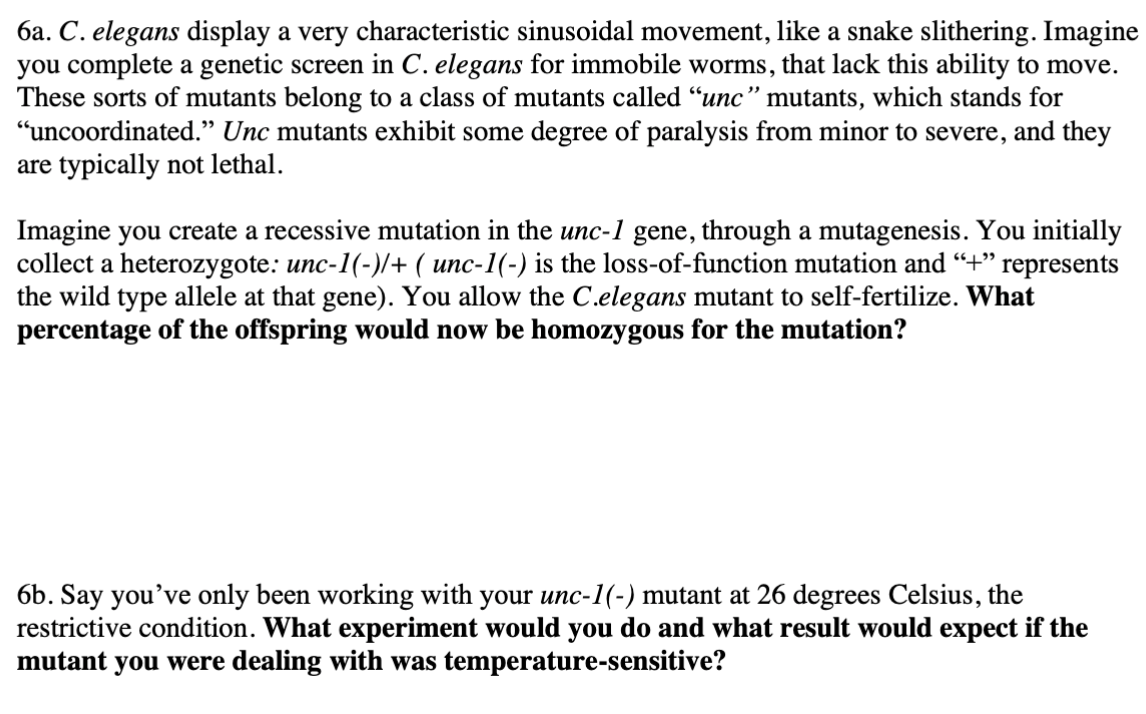6a. C. elegans display a very characteristic sinusoidal movement, like a snake slithering. Imagine you complete a genetic screen in C. elegans for immobile worms, that lack this ability to move. These sorts of mutants belong to a class of mutants called "unc" mutants, which stands for "uncoordinated." Unc mutants exhibit some degree of paralysis from minor to severe, and they are typically not lethal. Imagine you create a recessive mutation in the unc-1 gene, through a mutagenesis. You initially collect a heterozygote: unc-1(-)/+ ( unc-1(-) is the loss-of-function mutation and “+” represents the wild type allele at that gene). You allow the C.elegans mutant to self-fertilize. What percentage of the offspring would now be homozygous for the mutation? 6b. Say you've only been working with your unc-1(-) mutant at 26 degrees Celsius, the restrictive condition. What experiment would you do and what result would expect if the mutant you were dealing with was temperature-sensitive?
6a. C. elegans display a very characteristic sinusoidal movement, like a snake slithering. Imagine you complete a genetic screen in C. elegans for immobile worms, that lack this ability to move. These sorts of mutants belong to a class of mutants called "unc" mutants, which stands for "uncoordinated." Unc mutants exhibit some degree of paralysis from minor to severe, and they are typically not lethal. Imagine you create a recessive mutation in the unc-1 gene, through a mutagenesis. You initially collect a heterozygote: unc-1(-)/+ ( unc-1(-) is the loss-of-function mutation and “+” represents the wild type allele at that gene). You allow the C.elegans mutant to self-fertilize. What percentage of the offspring would now be homozygous for the mutation? 6b. Say you've only been working with your unc-1(-) mutant at 26 degrees Celsius, the restrictive condition. What experiment would you do and what result would expect if the mutant you were dealing with was temperature-sensitive?
Biology Today and Tomorrow without Physiology (MindTap Course List)
5th Edition
ISBN:9781305117396
Author:Cecie Starr, Christine Evers, Lisa Starr
Publisher:Cecie Starr, Christine Evers, Lisa Starr
Chapter10: Biotechnology
Section: Chapter Questions
Problem 2DID
Related questions
Question

Transcribed Image Text:6a. C. elegans display a very characteristic sinusoidal movement, like a snake slithering. Imagine
you complete a genetic screen in C. elegans for immobile worms, that lack this ability to move.
These sorts of mutants belong to a class of mutants called "unc" mutants, which stands for
"uncoordinated." Unc mutants exhibit some degree of paralysis from minor to severe, and they
are typically not lethal.
Imagine you create a recessive mutation in the unc-1 gene, through a mutagenesis. You initially
collect a heterozygote: unc-1(-)/+ ( unc-1(-) is the loss-of-function mutation and “+” represents
the wild type allele at that gene). You allow the C.elegans mutant to self-fertilize. What
percentage of the offspring would now be homozygous for the mutation?
6b. Say you've only been working with your unc-1(-) mutant at 26 degrees Celsius, the
restrictive condition. What experiment would you do and what result would expect if the
mutant you were dealing with was temperature-sensitive?
Expert Solution
This question has been solved!
Explore an expertly crafted, step-by-step solution for a thorough understanding of key concepts.
This is a popular solution!
Trending now
This is a popular solution!
Step by step
Solved in 3 steps

Knowledge Booster
Learn more about
Need a deep-dive on the concept behind this application? Look no further. Learn more about this topic, biology and related others by exploring similar questions and additional content below.Recommended textbooks for you

Biology Today and Tomorrow without Physiology (Mi…
Biology
ISBN:
9781305117396
Author:
Cecie Starr, Christine Evers, Lisa Starr
Publisher:
Cengage Learning

Biology 2e
Biology
ISBN:
9781947172517
Author:
Matthew Douglas, Jung Choi, Mary Ann Clark
Publisher:
OpenStax

Biology: The Dynamic Science (MindTap Course List)
Biology
ISBN:
9781305389892
Author:
Peter J. Russell, Paul E. Hertz, Beverly McMillan
Publisher:
Cengage Learning

Biology Today and Tomorrow without Physiology (Mi…
Biology
ISBN:
9781305117396
Author:
Cecie Starr, Christine Evers, Lisa Starr
Publisher:
Cengage Learning

Biology 2e
Biology
ISBN:
9781947172517
Author:
Matthew Douglas, Jung Choi, Mary Ann Clark
Publisher:
OpenStax

Biology: The Dynamic Science (MindTap Course List)
Biology
ISBN:
9781305389892
Author:
Peter J. Russell, Paul E. Hertz, Beverly McMillan
Publisher:
Cengage Learning

Human Heredity: Principles and Issues (MindTap Co…
Biology
ISBN:
9781305251052
Author:
Michael Cummings
Publisher:
Cengage Learning